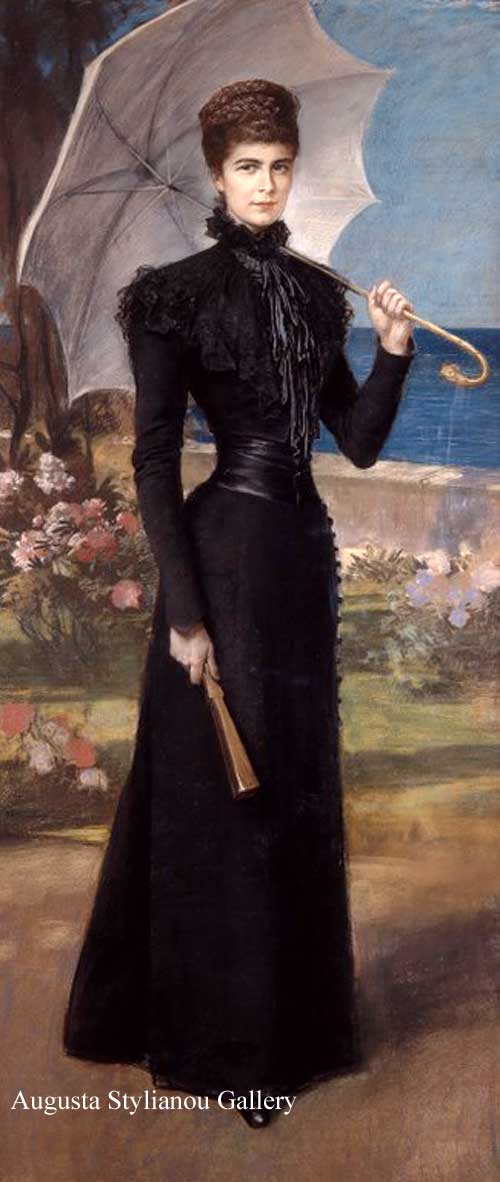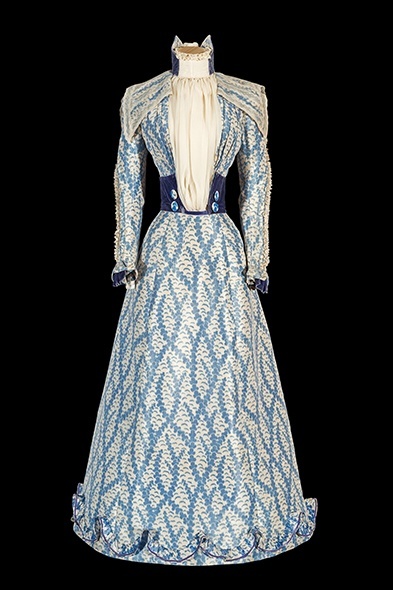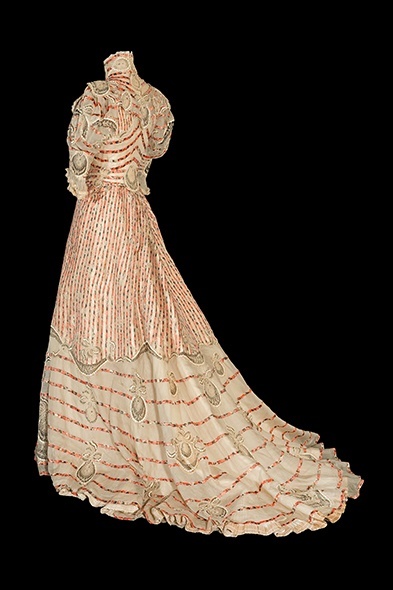|
ELISABETH’S GARDROBE: Sisi’s Favourite Colours
Káli-Rozmis Barbara 2016.01.08. 10:43
 ELISABETH’S GARDROBE: Sisi’s Favourite Colours ELISABETH’S GARDROBE: Sisi’s Favourite Colours
Elisabeth chose her own clothes and have them designed according to her own style, which was not dependant on the actual fashion but on her delicate taste. Not only the Viennese court companies but also the most elegant Parisian tailor, Worth made her dresses. Furthermore, she frequently had clothes delivered by Hungarian fashion companies as well.
What were her favourite colours? What were her favourite colour combinations? Why was she so much fond of black? The following article will answer all of these questions and will enlighten many others which you might not have read about yet.
Please click the "TOVÁBB" (continue) button.
ELISABETH’S GARDROBE: Sisi’s Favourite Colours
In the 19th century the colours of the women’s outfits were usually determined by the age: white, pink, light blue, pale green and pale yellow were the colours of the young, unmarried girls, while wearing more vivid, flashy colours, besides, gold and silver were the privilege of women. When they were over forty, duller colours such as brown, purple, and grey were regarded to be appropriate. Black was the colour of mourning and grief, and a proper colour of old women. (F. Dózsa)
 SISI LIKED BLACK SISI LIKED BLACK
Elisabeth liked black outfits since her youth. It was the colour she was wearing when the Emperor caught sight of her for the first time (actually for the second time since they had already met when both of them were younger). The meeting of the fifteen-year-old Elisabeth and the twenty-three-year-old Franz Joseph took place at a fashionable resort, Bad Ischl, on 16th August, 1853. Ludovica, Sisi’s mother, and her daughters arrived one and a half hour later than expected, in addition, the carriage delivering their clothes was fallen behind with their maids so they could not change dresses. Archduchess Sophie sent her maid to help her sister (Duchess Ludovica was Archduchess Sophie’s sister, so the couple were actually first cousins) and her nieces.
Ludovica, Helene and Sisi were wearing mourning dresses because of the death of an aunt. The simple, highly closed black dress fitted Sisi perfectly but Helene seemed to be rather strict in hers. According to many, it also played a role in the Emperor’s choice and that is why his marriage proposal was made so quickly...
Read more about it:
WHO CHOSE SISI’S CLOTHES?

 Before her wedding, it was definitely her mother, who selected the young bride’s trousseau (outfits). After her wedding, in the beginning it was her mother-in-law who took charge of Sisi’s wardrobe. Archduchess Sophie was well-known about hating Hungarians and everything that was Hungarian, however, ironically, it was her who gave the very first Hungarian dress to the young Empress. It was the gown Elisabeth was wearing when she met the Hungarian delegation during the following days of her wedding. This reception was followed by Sisi’s first court prom as an Empress, on which she was wearing a white dress with a thin brilliant belt around her waist, and her head was crowned by white roses and a tiara. Before her wedding, it was definitely her mother, who selected the young bride’s trousseau (outfits). After her wedding, in the beginning it was her mother-in-law who took charge of Sisi’s wardrobe. Archduchess Sophie was well-known about hating Hungarians and everything that was Hungarian, however, ironically, it was her who gave the very first Hungarian dress to the young Empress. It was the gown Elisabeth was wearing when she met the Hungarian delegation during the following days of her wedding. This reception was followed by Sisi’s first court prom as an Empress, on which she was wearing a white dress with a thin brilliant belt around her waist, and her head was crowned by white roses and a tiara.
Later, of course, Elisabeth chose her own clothes and have them designed according to her own style, which was not dependant on the actual fashion but on her delicate taste. Not only the Viennese court companies but also the most elegant Parisian tailor, Worth made her dresses. Furthermore, she frequently had clothes delivered by Hungarian fashion companies as well (F. Dózsa, 113-114).
THE LOVE OF BLACK-AND-WHITE COMBINATION
  Sisi was especially fond of combining black and white from the 1860s as it can be seen in many images of her. This colour combination is also striking on her royal coronation gown, which was made by the Parisian tailor, the above mentioned Charles Frederick Worth. It must be noted that this black-and-white combination is mainly for expressing Hungarian morning, for the occasion of the coronation, a red, green or blue velvet dress would have been more suitable, in accordance with this, her ladies-in-waiting were wearing colourful dresses. However, this beautiful black-and-white dress suited Sisi perfectly. My personal opinion is that one of her most stunning images were taken of her in this gown. Unfortunately, the dress was not preserved, however, thanks to a thorough work, the reproduction of it has already been made, which is probably as beautiful as the original one. This dress is often used by Dóra Szabó in the Royal Palace of Gödöllő at special occasions. Sisi was especially fond of combining black and white from the 1860s as it can be seen in many images of her. This colour combination is also striking on her royal coronation gown, which was made by the Parisian tailor, the above mentioned Charles Frederick Worth. It must be noted that this black-and-white combination is mainly for expressing Hungarian morning, for the occasion of the coronation, a red, green or blue velvet dress would have been more suitable, in accordance with this, her ladies-in-waiting were wearing colourful dresses. However, this beautiful black-and-white dress suited Sisi perfectly. My personal opinion is that one of her most stunning images were taken of her in this gown. Unfortunately, the dress was not preserved, however, thanks to a thorough work, the reproduction of it has already been made, which is probably as beautiful as the original one. This dress is often used by Dóra Szabó in the Royal Palace of Gödöllő at special occasions.
THE MYSTERY OF SISI’S PHOTOS OF THE HUNGARIAN CORONATION (1867) IS SOLVED - read more:
WAS WHITE SISI’S FAVOURITE COLOUR?
 Beside violet and lilac, white must have been Elisabeth’s favourite colour since she not only combined this with black but also with silver or gold and sometimes with green - Her farewell dress is also green and white, it must have been selected by her mother, though, as it has already be mentioned above. Beside violet and lilac, white must have been Elisabeth’s favourite colour since she not only combined this with black but also with silver or gold and sometimes with green - Her farewell dress is also green and white, it must have been selected by her mother, though, as it has already be mentioned above.
One of the most famous paintings of Elisabeth was made by Franz Xaver Winterhaltar in 1864. In this picture, Sisi is wearing a gold-embroidered white prom gown covered by tulle. The famous diamond stars can be seen in the Empress hair.
 About the diamond stars About the diamond stars
“The jeweller's company Köchert, likewise a former Court supplier, made a number of diamond stars, including ten-pointed stars with pearls at the centre. One of these stars was made available as a private loan on the occasion of the large special exhibition to honour the 100th anniversary of the death of Empress Elisabeth in Schönbrunn Palace in 1998, but was then stolen and found again 10 years later on another continent. This star was bought by Schloss Schönbrunn Kultur- und Betriebsges.m.b.H. in 2010. This original piece of jewellery is now on display as a permanent exhibit in the Sisi Museum.” http://www.schoenbrunn.at/en/nc/service/news/news-detail/artikel/sternenschmuck-der-kaiserin-elisabeth-1.html
WEARING BLACK: EXPRESSING GRIEF AND THE DESIRE FOR SEPARATION
 The black dress suited Sisi perfectly not only at her younger ages but also during her entire life since it emphasised her slim, tall figure and thin waist. The black dress suited Sisi perfectly not only at her younger ages but also during her entire life since it emphasised her slim, tall figure and thin waist.
Elisabeth loved simplicity and clarity. She refused to wear expensive jewellery and other accessories on weekdays, and felt rather unwell while being dressed up in fancy clothes. (She also wrote a poem about it.) One can imagine how heavy some of her dresses were! One, of which a painting can be seen in her former suite of the Royal Palace of Gödöllő, is said to weigh 50 kg!
After her only-son, Rudolf’s death, expect some occasions, she only wore black, but her accessories were white (black and white combination again): white parasol, white or black lace fan were also her essential companions. She hid her face behind her fan or her parasol whenever she met people or realized that one wanted to capture her image. After at the age of 30, Sisi did not let any photos be taken of her, so her older face is unknown (this will be the topic of another article, I will also write about her death mask prepared secretly).
Most Sisi-fans know that after the tragic death of her son, Elisabeth was constantly mourning (as far as her outfit was concerned) and was not willing to wear anything else but black. She was said to make only a very few exceptions, such as her youngest daughter, Marie Valerie’s wedding, where she was wearing a lilac dress.
The expression of mourning by wearing black outfit was intended to persuade people to keep away from her. Hiding her face was meant to cover her ageing skin, presenting her legendary beauty for the eternity.
THE EMPRESS' CORFU WARDROBE (From 1890)
  The following is highly important to be noted. As mentioned above, Sisi had her slender figure dressed in black in the countries of the monarchy, where she was well-known. However, outside the borders of the Austro-Hungarian Monarchy, where only a few ones knew that the graceful, slender middle-aged (or later elderly) woman with a lovely face was the Empress of Austria (Elisabeth usually travelled under pseudonym), Sisi might have preferred wearing light-coloured dresses. Two special pieces of her Corfu wardrobe have been preserved supporting this idea. The so-called "blue dress", which appeared in a not very attractive wooden box in a Munich auction in 2012, and the light-coloured, pink dress with dolphin motifs, both of them belonged to Elisabeth Corfu wardrobe. (Sisi started to have her stunning palace in Corfu (the place outside the Monarchy), the Achilleion built a year after the Mayerling Incident of 1889 - the death of the Crown Prince Rudolph.) The following is highly important to be noted. As mentioned above, Sisi had her slender figure dressed in black in the countries of the monarchy, where she was well-known. However, outside the borders of the Austro-Hungarian Monarchy, where only a few ones knew that the graceful, slender middle-aged (or later elderly) woman with a lovely face was the Empress of Austria (Elisabeth usually travelled under pseudonym), Sisi might have preferred wearing light-coloured dresses. Two special pieces of her Corfu wardrobe have been preserved supporting this idea. The so-called "blue dress", which appeared in a not very attractive wooden box in a Munich auction in 2012, and the light-coloured, pink dress with dolphin motifs, both of them belonged to Elisabeth Corfu wardrobe. (Sisi started to have her stunning palace in Corfu (the place outside the Monarchy), the Achilleion built a year after the Mayerling Incident of 1889 - the death of the Crown Prince Rudolph.)
Barbara Káli-Rozmis
Sources:
F. Dózsa Katalin: A világ legszebb asszonya. Erzsébet, a magyarok királynéja. Rubicon, Budapest, 2001
Katrin Unterreiner: Sisi - Myth and Truth
Brigitte Hamann: Erzsébet királyné. Európa Könyvkiadó, 2012
Gróf Corti Egon: Erzsébet. Révai Kadás, Budapest, 1935
Articles on this website are protected under copyright.
Articles published on the website are my own intellectual products. The texts may not be published in whole or in part without permission.
|

